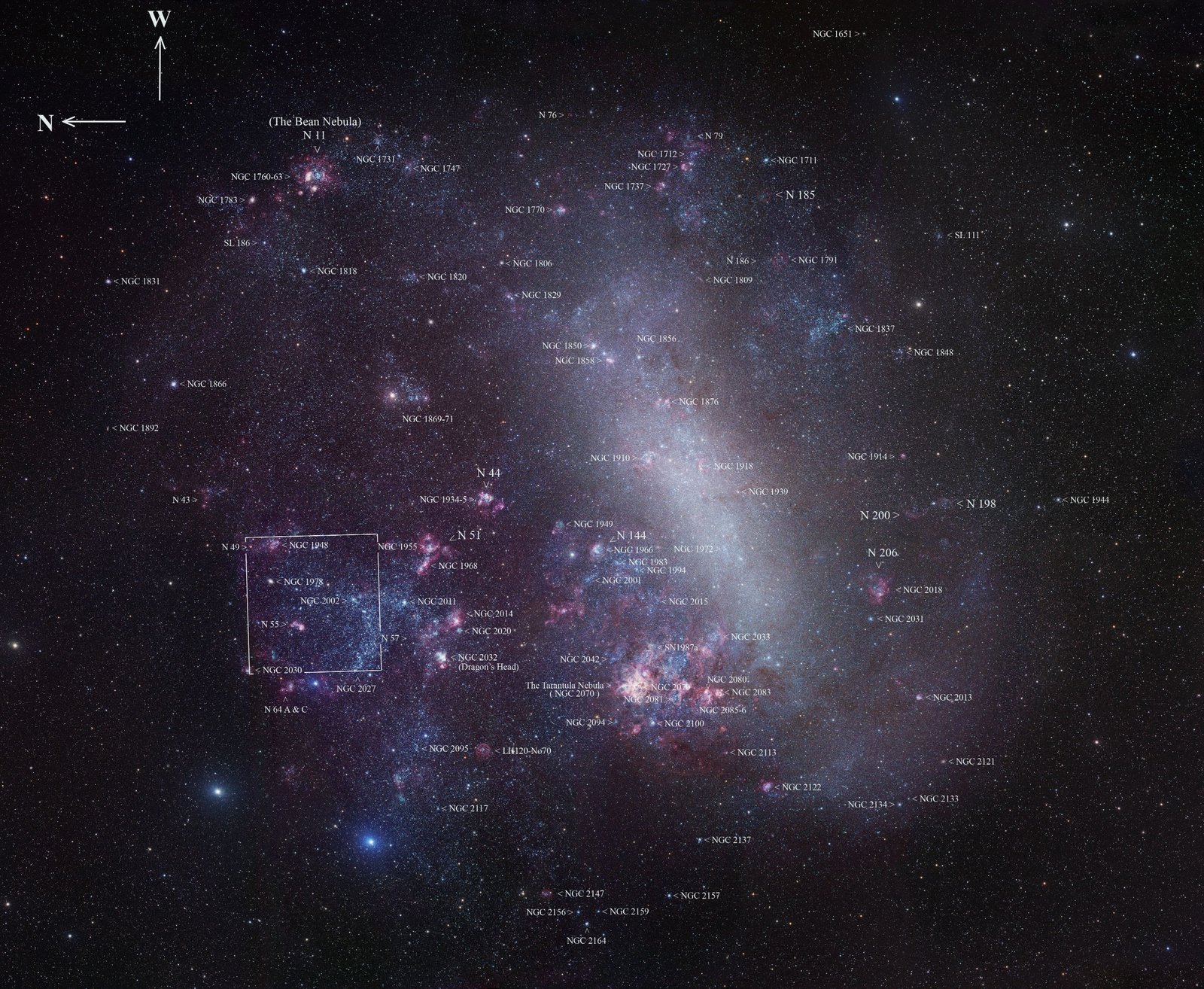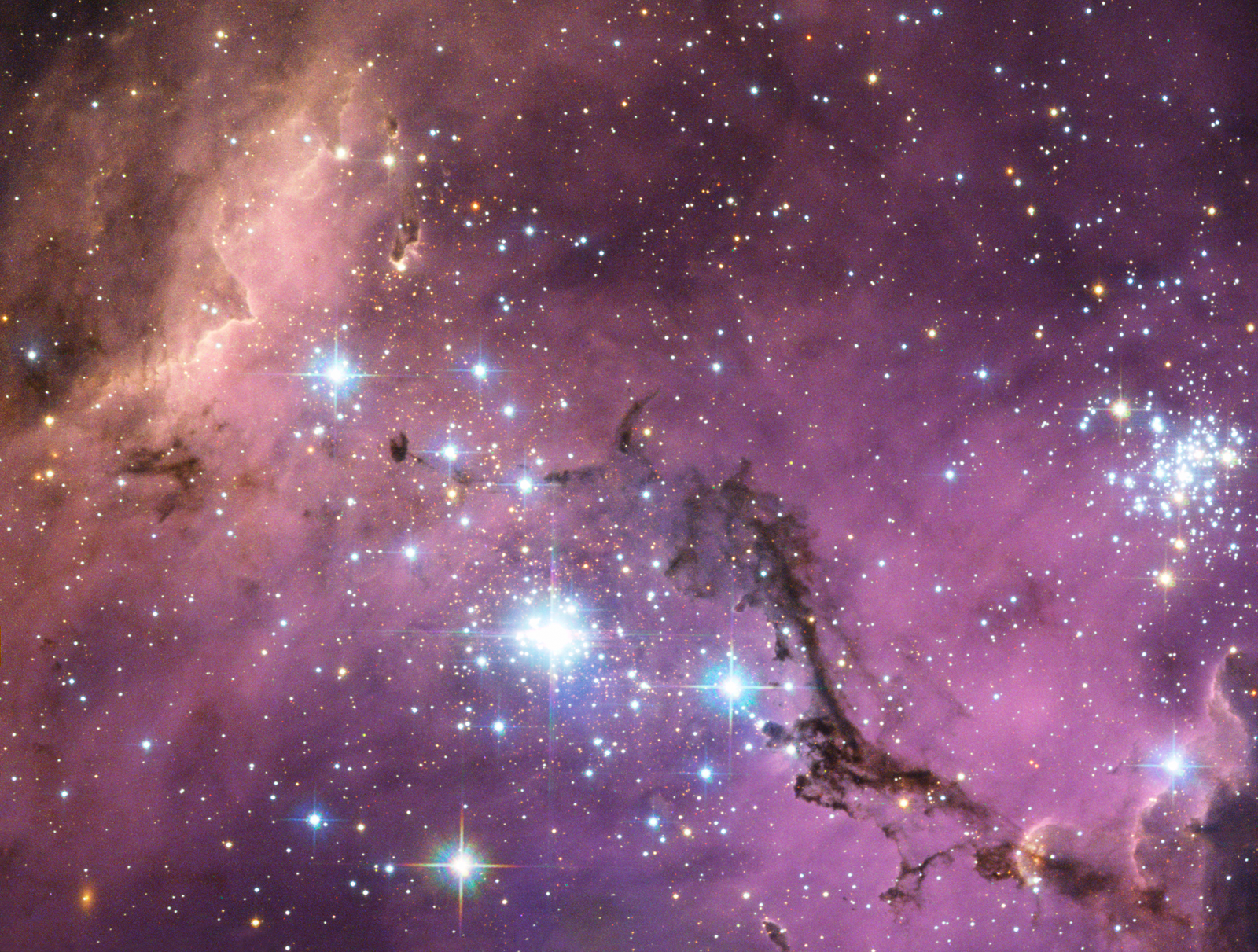Introduction
The vast expanse of the cosmos unfolds a myriad of celestial enigmas, presenting a grand arena for the unending quest of astronomy. Nestled within this universal expanse is the Large Magellanic Cloud (LMC)—a satellite galaxy of the Milky Way. Visible from the Southern Hemisphere, it stands as a beacon for celestial exploration, offering an observational gateway to the universe’s complexities. This narrative unfolds the mysteries of the Large Magellanic Cloud, highlighting its integral role in advancing cosmic knowledge.
An Overview of the Large Magellanic Cloud
The proximity of the Large Magellanic Cloud to our own galactic residence places it a mere 163,000 light-years from Earth. Distinct in its irregularity, the LMC rejects the common spiral configuration seen in its galactic neighbors, stretching across 14,000 light-years. Though dwarfed by the Milky Way, it boasts the status of the fourth-largest galaxy within our local galactic family—a family encompassing over fifty members, including the illustrious Andromeda and the Milky Way.

What is the angular size of the Large Magellanic Cloud?
With an angular expanse of 10.75 degrees, the Large Magellanic Cloud presents a striking vision against the backdrop of the night sky. This dimension is sufficient for it to stand as a prominent celestial body, observable without technological aid under opportune conditions. It has thus captured the wonder of observers across ages, beckoning a deep dive into its astral allure.
Historical Observations and Significance
The astronomical traditions of Southern Hemisphere’s indigenous cultures revered the Large Magellanic Cloud, incorporating it into their storied skyscapes. It awaited European scholarly attention until the voyages of Ferdinand Magellan, which bequeathed it the moniker we use today. Since then, the advancement in telescope technology has transitioned its study from curiosity to scientific rigor.
Unique Characteristics and Components
Hosting a diverse astral population, the Large Magellanic Cloud is a microcosm of cosmic evolution, with star clusters and nebulous gas intermingling with stellar birthplaces and graveyards. Among its renowned features is the Tarantula Nebula—akin to a cosmic colossus and the brightest nebula found in our local assembly of galaxies. Nearby, SN 1987A shines as a beacon, offering unprecedented clarity into the supernova phenomenon.
The Large Magellanic Cloud’s Role in Galactic Interaction and Evolution
The Large Magellanic Cloud’s relationship with the Milky Way is not a static one. They are embroiled in a gravitational waltz, producing the Magellanic Stream—a testament to the dynamic interactions that sculpt galactic life cycles. Such exchanges are pivotal in deciphering the elaborate mechanisms governing galaxies and, by extension, the fabric of the universe.
What will happen to the Large Magellanic Cloud?
Predictions on the LMC’s destiny suggest a monumental astral event: a merger with the Milky Way in the cosmic future. Such an event promises to reshape our galactic structure, potentially flinging stars into intergalactic space and sparking new stellar creation through the infusion of interstellar material.
The Large Magellanic Cloud as a Laboratory for Astrophysical Research
As a nexus for research, the Large Magellanic Cloud is invaluable. Its relative proximity lays the framework for incisive studies into stellar lifespans, galactic interplay, and the cyclic journey of cosmic material. Moreover, it is pivotal for calibrating astronomical distance, utilizing the rhythm of Cepheid variables to fine-tune our measurements of the cosmic vastness.
Recent Developments in Large Magellanic Cloud Research
Discovery of a New Spiral Arm in the Large Magellanic Cloud:
The Large Magellanic Cloud (LMC) has long been a subject of astronomical research due to its proximity and the unique opportunity it presents for the study of galactic evolution and morphology. The detection of a new spiral arm extends the understanding of the LMC’s structural composition, indicating that the Large Magellanic Cloud may have more in common with spiral galaxies than previously recognized. The data from the Dark Energy Survey has been instrumental in uncovering this extension, which may be crucial for grasping the formation and evolutionary history of the Large Magellanic Cloud.
This extended spiral arm, measuring approximately 2,000 light-years in length, offers researchers valuable data on the dynamics of the Large Magellanic Cloud and its star-forming capabilities, especially on the galaxy’s periphery. This newfound arm contributes a significant piece to the puzzle of the Large Magellanic Cloud’s complex gravitational interactions with the Milky Way and other celestial entities.
Discovery of a New Type of Supernova in the Large Magellanic Cloud:
In the field of supernova research, the Large Magellanic Cloud continues to be a hotspot for new findings. The detection by the Zwicky Transient Facility of a super luminous supernova within the Large Magellanic Cloud has brought forth new queries and understandings about these cosmic events. The LMC’s proximity to Earth allows for detailed observation of such super luminous supernovae. These events shine with a brilliance tenfold that of standard supernovae, providing a closer examination of their mechanics and implications on the interstellar environment.
Discovery of a New Dwarf Galaxy Orbiting the Large Magellanic Cloud:
Renaming the Magellanic Clouds: A Call for Inclusive Astronomy
For centuries, the cosmic duo of dwarf galaxies visible from Earth’s Southern Hemisphere has been known as the Magellanic Clouds. This nomenclature is now subject to scrutiny and potential change as an increasing number of voices within the astronomical community advocate for a title that is more respectful and inclusive of the Indigenous populations of the Southern regions.

Background
The historical name of these galaxies pays homage to Ferdinand Magellan, the Portuguese navigator whose expedition first documented the presence of these galaxies in European records in 1519. Magellan’s circumnavigation, a key moment in European naval history, highlights the tragic and violent impacts on Indigenous communities during European expansion. Magellan and his crew were involved in a multitude of conflicts and oppressive actions, leading to widespread Indigenous fatalities.
Arguments for Renaming
Advocates for renaming the Magellanic Clouds argue that the current name memorializes an era of colonization and oppression. They emphasize that such a designation neglects the significance of these celestial bodies to the Indigenous peoples. For them, the stars and cosmos are intimately tied to their heritage and existential philosophy.
Alternative Names
In the spirit of inclusivity and cultural sensitivity, various substitute names are under consideration. Some alternatives draw from Indigenous terminology, introducing words like “aw” and “kau,” denoting “cloud” in the Mapuche and Ona languages, respectively. Other suggestions aim for descriptive simplicity, such as “Meridional Clouds” or “Milky Clouds,” which are indicative of their appearance or geographical prominence.
Current Status
The discourse surrounding the potential rechristening of the Magellanic Clouds remains active and divisive within the community of astronomers. Despite no consensus being reached and no formal decision rendered, the discussion persists at conferences and in academic writings.
The momentum behind renaming these galaxies aligns with a larger initiative to reshape astronomy into a field that acknowledges and honors the diverse cultural connections to the cosmos. The discipline’s expansion and increasing diversity indeed call for a reflective examination. Consequently, it is imperative to thoroughly review the language and methodologies employed. This approach is essential to guarantee that they resonate with a spirit of inclusiveness and respect.
Challenges and Opportunities in Large Magellanic Cloud Research
Investigating the Large Magellanic Cloud presents astronomers with a variety of challenges, including its dynamic interactions and the obscuring effects of interstellar dust. However, these challenges do not deter but rather motivate a deeper inquiry into the Large Magellanic Cloud’s nature. The expected contributions from cutting-edge instruments like the James Webb Space Telescope and the Gaia spacecraft promise to sharpen the view of the Large Magellanic Cloud and deepen the understanding of its role in the universe.





